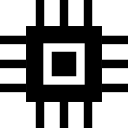Computer organization: Difference between revisions
Mr. MacKenty (talk | contribs) |
|||
| (29 intermediate revisions by 2 users not shown) | |||
| Line 1: | Line 1: | ||
[[file:cpu.png|right|frame|Computer Organization<ref>http://www.flaticon.com/</ref>]] | [[file:cpu.png|right|frame|Computer Organization<ref>http://www.flaticon.com/</ref>]] | ||
How does a | How does a CPU '''actually work'''? | ||
== Big ideas in computer organization == | == Big ideas in computer organization == | ||
This lecture (quite long) is an excellent introduction to the deeper ideas presented on this page. I strongly advise you to watch this. | |||
=== | <html> | ||
<iframe width="560" height="315" src="https://www.youtube.com/embed/PLigQUosV34" frameborder="0" allowfullscreen></iframe> | |||
</html> | |||
* [[Binary | |||
=== Computer architecture === | |||
* [[Architecture of the central processing unit (CPU)]] | |||
* [[Functions of the arithmetic logic unit (ALU)]] | |||
* [[Control unit (CU)]] | |||
* [[Registers within the CPU]] | |||
* [[Primary memory]] | |||
* [[Cache memory]] | |||
* [[The machine instruction cycle]] | |||
=== Secondary memory === | |||
* [[Persistent storage]] | |||
=== Operating systems and application systems === | |||
* [[Operating system]] | |||
* [[Application software]] | |||
=== Binary Representation === | |||
* [[Binary]] | |||
* [[Hexadecimal]] | |||
* [[ASCII]] | |||
* [[Data representation]] | * [[Data representation]] | ||
=== | === Simple logic gates === | ||
* [[ | * [[Boolean operators]] | ||
* [[ | * [[Truth tables]] | ||
* [[Logic diagram]] | |||
=== | == Standards == | ||
* Outline the architecture of the central processing unit (CPU) and the functions of the arithmetic logic unit (ALU) and the control unit (CU) and the registers within the CPU. | |||
* Describe primary memory. | |||
* Explain the use of cache memory. | |||
* Explain the machine instruction cycle. | |||
* Identify the need for persistent storage. | |||
* Describe the main functions of an operating system. | |||
* Outline the use of a range of application software. | |||
* Identify common features of applications. | |||
* Define the terms: bit, byte, binary, denary/decimal, hexadecimal. | |||
* Outline the way in which data is represented in the computer. | |||
* Define the Boolean operators: AND, OR, NOT, NAND, NOR and XOR. | |||
* Construct truth tables using the above operators. | |||
* Construct a logic diagram using AND, OR, NOT, NAND, NOR and XOR gates. | |||
== References == | == References == | ||
Revision as of 08:10, 28 August 2018

Computer Organization[1]
How does a CPU actually work?
Big ideas in computer organization[edit]
This lecture (quite long) is an excellent introduction to the deeper ideas presented on this page. I strongly advise you to watch this.
Computer architecture[edit]
- Architecture of the central processing unit (CPU)
- Functions of the arithmetic logic unit (ALU)
- Control unit (CU)
- Registers within the CPU
- Primary memory
- Cache memory
- The machine instruction cycle
Secondary memory[edit]
Operating systems and application systems[edit]
Binary Representation[edit]
Simple logic gates[edit]
Standards[edit]
- Outline the architecture of the central processing unit (CPU) and the functions of the arithmetic logic unit (ALU) and the control unit (CU) and the registers within the CPU.
- Describe primary memory.
- Explain the use of cache memory.
- Explain the machine instruction cycle.
- Identify the need for persistent storage.
- Describe the main functions of an operating system.
- Outline the use of a range of application software.
- Identify common features of applications.
- Define the terms: bit, byte, binary, denary/decimal, hexadecimal.
- Outline the way in which data is represented in the computer.
- Define the Boolean operators: AND, OR, NOT, NAND, NOR and XOR.
- Construct truth tables using the above operators.
- Construct a logic diagram using AND, OR, NOT, NAND, NOR and XOR gates.